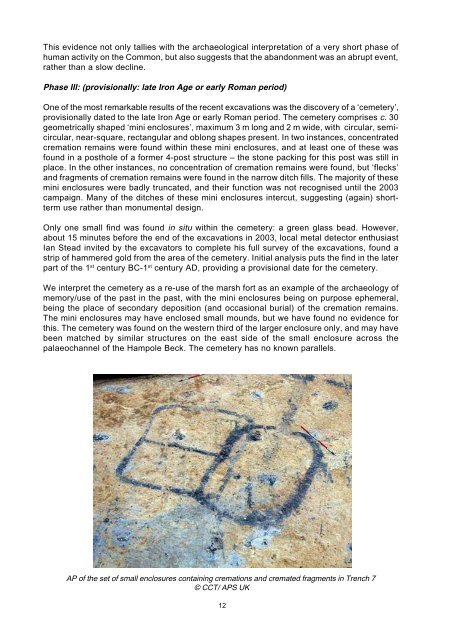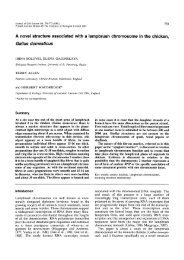Sutton Common Updated project design - University of Exeter
Sutton Common Updated project design - University of Exeter
Sutton Common Updated project design - University of Exeter
Create successful ePaper yourself
Turn your PDF publications into a flip-book with our unique Google optimized e-Paper software.
This evidence not only tallies with the archaeological interpretation <strong>of</strong> a very short phase <strong>of</strong><br />
human activity on the <strong>Common</strong>, but also suggests that the abandonment was an abrupt event,<br />
rather than a slow decline.<br />
Phase III: (provisionally: late Iron Age or early Roman period)<br />
One <strong>of</strong> the most remarkable results <strong>of</strong> the recent excavations was the discovery <strong>of</strong> a ‘cemetery’,<br />
provisionally dated to the late Iron Age or early Roman period. The cemetery comprises c. 30<br />
geometrically shaped ‘mini enclosures’, maximum 3 m long and 2 m wide, with circular, semicircular,<br />
near-square, rectangular and oblong shapes present. In two instances, concentrated<br />
cremation remains were found within these mini enclosures, and at least one <strong>of</strong> these was<br />
found in a posthole <strong>of</strong> a former 4-post structure – the stone packing for this post was still in<br />
place. In the other instances, no concentration <strong>of</strong> cremation remains were found, but ‘flecks’<br />
and fragments <strong>of</strong> cremation remains were found in the narrow ditch fills. The majority <strong>of</strong> these<br />
mini enclosures were badly truncated, and their function was not recognised until the 2003<br />
campaign. Many <strong>of</strong> the ditches <strong>of</strong> these mini enclosures intercut, suggesting (again) shortterm<br />
use rather than monumental <strong>design</strong>.<br />
Only one small find was found in situ within the cemetery: a green glass bead. However,<br />
about 15 minutes before the end <strong>of</strong> the excavations in 2003, local metal detector enthusiast<br />
Ian Stead invited by the excavators to complete his full survey <strong>of</strong> the excavations, found a<br />
strip <strong>of</strong> hammered gold from the area <strong>of</strong> the cemetery. Initial analysis puts the find in the later<br />
part <strong>of</strong> the 1 st century BC-1 st century AD, providing a provisional date for the cemetery.<br />
We interpret the cemetery as a re-use <strong>of</strong> the marsh fort as an example <strong>of</strong> the archaeology <strong>of</strong><br />
memory/use <strong>of</strong> the past in the past, with the mini enclosures being on purpose ephemeral,<br />
being the place <strong>of</strong> secondary deposition (and occasional burial) <strong>of</strong> the cremation remains.<br />
The mini enclosures may have enclosed small mounds, but we have found no evidence for<br />
this. The cemetery was found on the western third <strong>of</strong> the larger enclosure only, and may have<br />
been matched by similar structures on the east side <strong>of</strong> the small enclosure across the<br />
palaeochannel <strong>of</strong> the Hampole Beck. The cemetery has no known parallels.<br />
AP <strong>of</strong> the set <strong>of</strong> small enclosures containing cremations and cremated fragments in Trench 7<br />
© CCT/ APS UK<br />
12
















